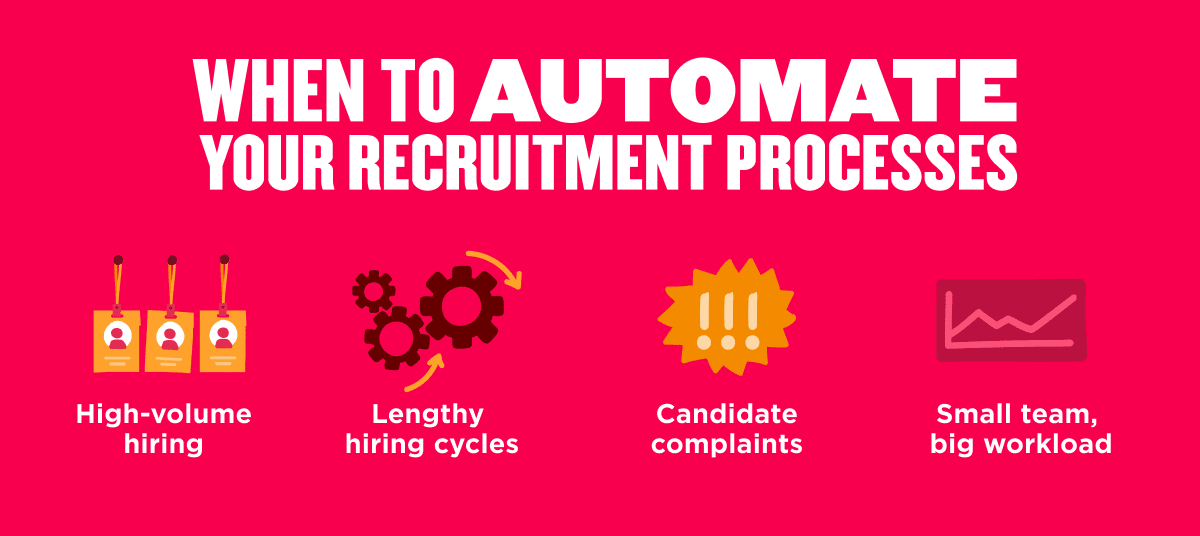Hiring demands are rising, and HR teams are under pressure to fill roles quickly without compromising on quality. Recruitment automation can make all the difference. By automating the right parts of the process, companies can bring in the right talent faster and free up time to focus on candidate experience and strategic decision-making. And it’s gaining momentum: Over half of HR teams are planning to increase their recruitment automation budgets.
In this article, we’ll show how recruitment automation can reshape your hiring process, giving your HR team more time to build meaningful connections and find the best fit for every role.
<< Simplify recruitment with this hiring process checklist. >>
Key insights
- Recruitment automation uses AI, machine learning, and process automation to streamline repetitive hiring tasks
- Common triggers for adopting automation include high-volume hiring, long time-to-fill metrics, and candidate experience issues
- Tools can automate resume screening, interview scheduling, post-interview feedback collection, and more
- Data-driven decision-making supported by automation helps reduce unconscious bias and improve hiring quality
- Strategic automation frees HR teams to focus on candidate relationships and talent planning
What is recruitment automation?
Recruitment automation uses technology to streamline repetitive, time-consuming tasks throughout the hiring process. It leverages artificial intelligence, machine learning, and robotic process automation to create efficient workflows that reduce manual effort while improving hiring outcomes.
Modern recruitment automation tools act as a hiring team’s digital assistant, taking over administrative tasks so recruiters and HR teams can focus on meaningful candidate interactions. These tools range from basic applicant tracking systems to sophisticated e-recruitment platforms that source candidates, screen applications, and personalize communication at scale.
Forward-thinking HR teams prefer using AI in HR over traditional recruiting methods that rely heavily on manual work. Instead, they shift toward strategic candidate engagement and assessment, using automation for talent management.
When should you automate your recruitment process?
You may not need full-scale recruitment automation—but if your team is feeling stretched, here are the signs it could make a big impact.
- High-volume hiring: You’re regularly sorting through hundreds of applications per role
- Administrative overload: Recruiters spend more time scheduling interviews and updating spreadsheets than engaging with candidates
- Lengthy hiring cycles: Your time-to-hire and time-to-fill metrics consistently lag behind benchmarks
- Candidate complaints: You hear feedback about delayed responses or unclear next steps
- Small team, big workload: Your recruiting team is stretched thin and juggling too many roles at once
If several of these feel familiar, it’s a sign your recruitment process could benefit from automation. Start by pinpointing the stages that take up the most time or cause the most friction—for example, interview scheduling, resume screening, or candidate follow-ups. Then, explore tools that can lighten the load without sacrificing the personal touch.
Automation doesn’t have to be all-or-nothing. Many HR teams start small—automating just one task—and expand as they see the impact. The right tools make hiring more efficient and more human, freeing your team to focus on what matters most: finding great people and building real connections.

Benefits of recruitment automation
Recruitment automation doesn’t just speed up hiring—it reshapes how HR teams work. Automating manual tasks creates space to focus on high-value, human-centered work like building relationships and improving candidate experience. It also helps you move faster without losing quality and make smarter, data-backed decisions every step of the way.
Data-driven decision making
Recruitment automation provides access to insights that aren’t available with manual processes. These analytics can help teams make hiring decisions based on concrete data rather than gut feelings. With automation tools tracking your entire recruitment funnel, HR teams gain visibility into:
- Source effectiveness: Identifying which channels deliver your best candidates
- Quality metrics: Tracing how candidates from different sources perform after hiring
- Conversion patterns: Determining where candidates drop out of your process
Advanced systems can even help predict candidate success based on patterns from previous hires. This predictive capability helps recruiters prioritize the most promising candidates in their pipeline.
Perhaps most importantly, data-driven approaches help minimize unconscious bias in hiring. By establishing structured, objective screening criteria, you ensure candidates are evaluated on relevant qualifications—not subjective impressions.
Reduced hiring costs
Recruitment automation creates real savings by streamlining the most time-consuming parts of the hiring process. When your team spends less time on manual processes, cost-per-hire goes down—and recruiters can focus on building connections with top candidates instead of sorting through unqualified ones. You can also rely less on external recruiting agencies. Built-in sourcing features help you find qualified candidates in-house, cutting out expensive agency fees without sacrificing quality.
Faster hiring cycles bring even more savings. Every day a role sits unfilled is a day of lost productivity. Automation helps close that gap by speeding up screening, scheduling, and communication—so you can fill key roles faster and keep your business moving.
Improved candidate experience
Today’s candidates expect a responsive, transparent hiring process—and nearly half of job seekers say they’ll turn down a job offer because of a less-than-par hiring experience.
Recruitment automation helps deliver this experience without overwhelming your HR team. They can leverage recruitment management systems to automate communication and keep candidates informed at every stage. No more leaving applicants wondering if their resume disappeared into the void—automation ensures timely updates and feedback.
Mobile-friendly application processes, enabled by modern automation tools, can allow candidates to apply from any device in minutes. This accessibility can significantly increase your application completion rates.
Personalized engagement also becomes possible at scale through automation. You can tailor communications based on a candidate’s background, interests, and stage in the hiring process—creating a more human experience despite the technology involved.
Less recruiter burnout
Recruiters bring energy, insight, and connection to the hiring process—but too often, they’re buried in repetitive admin that drains their time and momentum. Recruitment automation takes that pressure off by handling the manual work behind the scenes.
With fewer forms to fill and calendars to manage, recruiters can focus on what truly drives value:
- Building meaningful relationships with potential hires
- Crafting long-term talent strategies
- Acting as trusted partners to the business
When recruitment professionals spend more time using their expertise—not chasing paperwork—they’re more engaged, more effective, and more fulfilled in their roles.
Where you can automate your recruitment process
Recruitment automation can transform nearly every stage of the hiring process. Understanding where to apply these tools helps you maximize their impact while maintaining the human elements essential to effective hiring.
Candidate sourcing and screening
Automation changes how teams identify and evaluate potential candidates. For example, job description optimization tools improve the effectiveness of your postings by suggesting language that attracts diverse, qualified candidates. These tools analyze successful listings to recommend improvements that expand your reach.
Resume parsing technology extracts and organizes candidate information into standardized formats for easier comparison. This eliminates manual data entry and creates consistent candidate profiles for evaluation. Then, once candidate data is structured, re-screening assessments can automatically evaluate qualifications before a recruiter steps in. These might include:
- Skills assessments tailored to role requirements
- Job-specific scenario questions
- Basic qualification verification
These tools help HR teams move quickly and make confident, informed decisions. However, speed shouldn’t come at the cost of fairness. Human oversight remains essential—regularly reviewing criteria and outcomes helps ensure the technology supports inclusive, unbiased hiring.
<< Download our free job description template to speed up recruitment. >>
Interview scheduling
The back-and-forth of coordinating interviews consumes valuable time for recruiters and candidates alike. Automation eliminates this administrative burden in several ways.
- Calendar integration allows scheduling systems to view availability across multiple interviewers and automatically identify potential meeting times. This eliminates the need to manually check multiple calendars and reduces scheduling delays.
- Candidate self-scheduling empowers applicants to select interview slots that work for their schedule. This puts candidates in control and eliminates the frustrating email chains that often characterize traditional scheduling.
- Automated reminders significantly reduce interview no-shows by sending timely notifications to all participants. These systems can be configured to send reminders at optimal intervals before scheduled meetings.
For complex hiring processes involving multiple interviewers, automation helps coordinate panel interviews by finding times that work for everyone. This is particularly valuable for senior roles requiring input from various stakeholders.
Post-interview evaluations
Collecting feedback after interviews can be a challenge—especially when interviewers have packed calendars, different approaches, and no shared system for evaluating candidates. Without a consistent process, great insights can get lost or delayed, slowing down decision-making and creating a frustrating experience for everyone involved.
HR teams can streamline this by setting up clear, repeatable post-interview evaluation steps such as:
- Standardized feedback forms: Ensures all interviewers evaluate candidates on the same criteria. These forms can be automatically distributed immediately after each interview, improving response rates and consistency.
- Automated scoring systems: Helps quantify qualitative feedback, making it easier to compare candidates objectively. These tools can weigh different criteria based on their importance to the role.
- Comparative analysis features: Allows hiring teams to evaluate candidates side-by-side across multiple dimensions. This visual representation helps identify strengths and weaknesses more effectively than traditional notes.
- Decision support tools: Aggregates feedback from multiple interviewers to highlight consensus and disagreement. This accelerates decision-making by focusing the discussion on areas where perspectives differ.
Candidate engagement
Ongoing communication during the hiring process can make or break the candidate experience—and it directly impacts your ability to attract and convert top talent. But staying in touch manually at every stage isn’t always realistic for busy recruiters.
That’s where automation comes in. Automated email sequences keep candidates informed, set expectations, and reduce uncertainty—without adding to your team’s workload. These messages can be personalized based on the candidate’s background, the role they’re applying for, and where they are in the pipeline.
HR teams can use chatbots to provide immediate responses to common candidate questions at any time of day. These tools can answer questions about the role and hiring process or share personalized content based on candidates’ interests. This might include:
- Day-in-the-life content for specific roles
- Company values and mission information
- Benefits and perks details
- Guidance on next steps to help candidates prepare for interviews or assessments
Accessible information helps reduce repetitive questions for recruiters and keeps talent engaged throughout the process.
Streamline hiring with recruitment automation
Recruitment automation turns hiring into a smoother, more efficient experience—for HR teams, recruiters, and candidates alike. Offloading repetitive tasks creates space for your team to focus on what matters most: building real connections and making thoughtful hiring decisions.
The future of hiring isn’t about replacing people—it’s about empowering them. With the right tools in place, your team gains the time, insights, and confidence to find the best talent faster and create a hiring experience that reflects your company’s values.
<< Discover the best HR automation tools to improve recruitment. >>
FAQs about recruitment automation
What is the difference between an ATS and recruitment automation?
An applicant tracking system manages applications and tracks candidates, while recruitment automation includes ATS functionality plus tools that automate sourcing, screening, scheduling, and engagement across the entire recruitment lifecycle.
How does AI improve the recruitment process?
AI enhances recruitment by analyzing data to identify qualified candidates faster, reducing bias through standardized screening, enabling personalized engagement at scale, and providing predictive insights about candidate success potential.
Recommended For Further Reading
Will recruitment automation replace recruiters?
No, recruitment automation handles administrative tasks. This enables recruiters to focus on relationship-building, candidate assessment, and strategic hiring decisions requiring human judgment.
How can small businesses benefit from recruitment automation?
Small businesses can utilize recruitment automation to compete for talent by streamlining processes, reducing administrative tasks, creating a professional candidate experience, and making data-driven hiring decisions despite limited resources.
